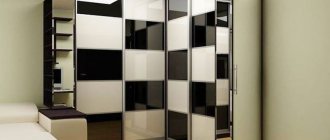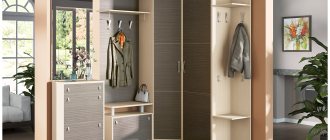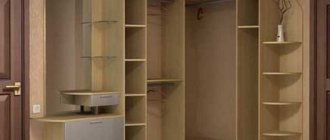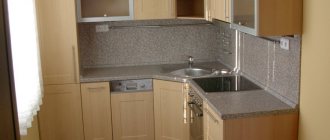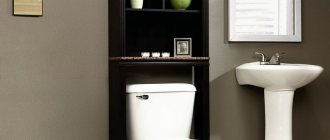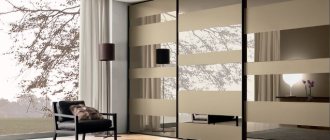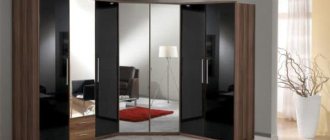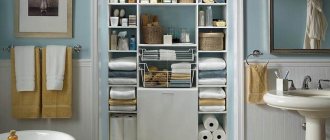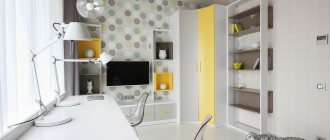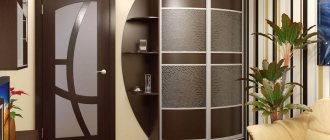128159
Corner cabinets are popular pieces of furniture that allow you to take up space that is not usually used for any purpose. They can be created from different materials and in a variety of styles, which allows you to choose a great option for any kitchen. The installed corner kitchen cabinet has different types, sizes, drawings that you can choose at your discretion.
Design advantages
The positive aspects that distinguish a corner wall cabinet for the kitchen include:
- increasing the usable area of the room due to proper placement of furniture. Installation is carried out in places where it is difficult to install other options;
- high capacity and functionality. At first glance, it may seem that corner floor cabinets are not so large, however, inside them you can install a variety of shelves and arrange compartments for organized storage of food and utensils;
- the ability to choose optimal sizes, since floor-standing cabinets are varied in size. Almost every person is able to understand how to assemble comfortable cabinets for the kitchen, giving them the necessary parameters;
- variety of methods that can be used to decorate front panels. If desired, the kitchen floor cabinet can be decorated with glass inserts or patterns. This will make the finished product more attractive. However, Leroy Merlin kitchens already look aesthetically pleasing and do not require any additions;
- Possibility of combination with other items in the kitchen.
Main features of corner models
The list of the most important differences includes:
- doors are not required. The open top cabinet is great for storing beautiful crockery sets;
- variety of forms. The design can be triangular, L-shaped, or even trapezoidal (by the way, triangular variations have become very widespread in our time). Choosing the right varieties depends on the people who will be using the cabinets and their preferences;
- the lower part of the structure, located on the floor, is often used to create sinks. The sink placed on top will be convenient to use;
- it is possible to integrate large types of household appliances for their more efficient operation;
- Various methods are used to decorate the facade. The most common options are applying a pattern to wall cabinets or upholstering them with some material;
- the lower cabinet under the sink is often equipped with legs, which makes cleaning the room easier;
- The upper corner cabinet can be equipped with carousel shelves to store dishes and other accessories.
Varieties
The furniture departments offer a wide variety of kitchen sets, differing in the way the doors open, the shape of the cabinet, and their location in the kitchen. Before purchasing, you should familiarize yourself with the various designs and choose the best option. An important selection criterion is the area of the room.
By the presence and type of door opening
The presence of only one non-standard type of door does not allow full use of the entire space of the shelf behind it, so manufacturers have created many devices and mechanisms. Kitchen cabinets have several types of door openings:
- Hinged or folding. Attached with hinges. Opening is possible in one of three directions: towards you, up, down. The advantages are simple installation, easy operation and low cost. Such doors are not suitable for small spaces because they require a lot of space to open.
- Sliding. You don't need a place to open them. Here there is a need for additional details - guides. In addition, incomplete opening of the cabinet does not make it possible to get to the things located in the depths.
- Accordion or book. They look stylish and compact. The problem with such designs is the rapid failure of the rotating mechanism. Used only in floor-standing modules.
Swing
Sliding
Harmonic
By shape
Kitchen cabinets can be of any shape - this allows you to choose furniture for different rooms. Main varieties:
- L-shaped. Optimal for a small kitchen. It installs simple door opening mechanisms and maintains the usefulness of the corner.
- Triangular. Characterized by a minimum number of parts, simple assembly and installation. You can make such a cabinet yourself, but not every kitchen has room for this type of furniture. It is impossible to connect with other modules because there are no right angles.
- Trapezoidal. Due to its shape, assembling such a module poses some difficulties, but its advantage is that such a cabinet can fit into any interior and style. A trapezoid holds much more household utensils (about 10-20%) than other types of cabinets. It allows you to align the transitions from wall to wall.
- Radial. They have five walls, but the doors are installed in a round shape so as not to hit the corners. This is a modern and original headset element that requires a competent design solution.
L-shaped
Triangular
Trapezoidal
Radial
By location
Today, 4 types of furniture are produced:
- Wall mounted upper corner cabinet. Available in 4 types, used for storing dishes, spices, and detergents. It allows you to usefully occupy a corner, which with other types of structures remains a dead zone. In order for such a piece of furniture to fit well into a specific place, it is advisable to first draw a drawing - this will help you choose the desired shape.
- Lower floor. It also has 4 subtypes: L-shaped, triangular, trapezoidal, radial. A unified kitchen style involves installing identical cabinets at the bottom and at the top, but this rule is violated due to the need to install household appliances in the floor modules.
- Corner cabinets under the sink. This type of furniture is relevant for small-sized kitchens in “Khrushchev” and “Brezhnevka” buildings. Basically, a corner cabinet of a trapezoidal or radial shape is used here.
- Cabinet-pencil case. Nowadays this is an extremely rare and expensive type of furniture; it is practically not used. There is a division into categories: closed (three sections in the same style), open (for crystal and tableware), combined (doors are located in the upper and lower parts).
What furniture to choose for a small kitchen, secrets of saving space
Mounted
Floor
Under the sink
Pencil case
Corner kitchen cabinet dimensions
The dimensions of kitchen furniture can vary widely. If they are included in the kitchen set, then they have optimal sizes for combining with other components of the set. If the cabinet is selected separately or designed independently, then it must match the other elements.
For a person who is going to create a corner kitchen cabinet with his own hands, it is very important to determine the dimensions of the future product. They are poured depending on whether the new piece of furniture will be located on the floor or on the wall.
The corner-type hanging cabinet has standard dimensions. The width is 15-80 cm, and this parameter must correspond to the shape of the cabinet and its width. The standard depth is 35 cm, however, the calculation must take into account the depth of the drawers that will be located below. It is recommended to install the finished product at a distance of 50 cm from the cabinets located below. These are the standard dimensions of any wall cabinet. Those people who are interested in how to calculate the corner option without making a mistake need to know this.
If we are talking about creating floor furniture, then it will have other standard sizes. They need to be taken into account when planning to make a kitchen drawing. For a compact room, a cabinet with a depth of 50 cm, no more, is better suited. The typical height is 85 cm (however, this can be varied in individual cases). The width can be 15-80 cm, with the optimal figure being 60 cm.
As a rule, the lower element is installed after the installation of the upper one has been completely completed. The owner has the right to choose furniture with or without legs.
Corner cabinet for sink
A cabinet under the sink is a very common option. Its dimensions can vary widely, as they depend on the washing parameters. You also need to take into account the method by which the structure will be secured. For such cabinets, standard sizes are calculated individually. The width can be more than 60 cm, and the depth can reach 80 cm (the downside is that such an interior element will be very difficult to use). As a rule, for large products a pair of facades is chosen. However, if necessary, assemble models with one door.
Accessories
Kitchen fittings are necessary to increase functionality and comfort when using drawers and cabinets. High-quality devices are not cheap, but you can be sure of their longevity. The mechanism for opening doors comes in three varieties: elevator, retractable, swing. The latter is used most often because it is inexpensive. Mainly found on floor-standing modules. The second most popular is retractable - this means that the door will open along with the contents of the shelf. It is durable and able to withstand heavy weight. The elevator mechanism raises and lowers the doors - all you need to do is push them slightly. There is an expensive version of this mechanism, when you need to pull a little towards yourself so that the structure moves smoothly to the side.
Types of furniture facades for the kitchen, selection criteria
The retractable mechanism initially allowed the cabinet to be pulled out no more than 5/6 of the entire length. Now they have begun to install a more advanced system, the element opens completely. Multiple layers of rails allow the heavy weight of the load placed in each cabinet to be supported. This eliminates sagging, even when fully extended.
Hinges are of no small importance for any furniture - thanks to them, doors open and close. In the kitchen, such a mechanism must be as reliable as possible due to intensive use. The following types of hinges are used for corner kitchen cabinets:
- Simple. Such loops are used for basic options, since these are the cheapest and most primitive products. The door opening angle is 90 degrees.
- Special. There is a locking mechanism that allows you to manually adjust the door opening angle. This means that you can stop the process at any time, and the element will be fixed. When you need to close the door, it is slightly raised.
- Spring. In this case, the facade rises parallel to the cabinet.
- Gas lifts. These are the most convenient of all the types of loops presented above. Their advantage is that the closing and opening of the facade occurs by light pressure.
Installing closers in a corner cabinet performs the main task - to prevent a strong blow when closing. The mechanism controls that the process is slow, soft and smooth. Even if you want to, you won’t be able to slam the door; the closer immediately prevents any attempt at a sharp blow.
With the advent of built-in sliding cargo baskets, using the kitchen is greatly simplified. After installing them, all the little things will always be at hand. Here you can divide things into categories.
Previously, in order to get something you needed, located at the very end, you had to disassemble half the shelf. With the advent of "magic" corners, any item is accessible without having to remove the internal contents of the shelf. A complex mechanism is installed here, and accordingly, its cost is high. You can order a carousel for the top cabinet, but it is better to use simple shelves for easy access to the things you need.
Simple
Special
Spring
Gas lift
Taking measurements and drawings
The assembly of a corner cabinet cannot begin without creating a diagram. In turn, to carry out drawing work, you need to take measurements, and then create a kitchen diagram so as not to make a mistake. When performing this work, you need to take into account some nuances:
- The thickness of the walls should be chosen taking into account what objects will be placed on them. It is important to show on the diagram whether the finished structure will accommodate household appliances or not. The thickness of typical shelves is 18 mm. If you plan to store something heavy on them, it is better to choose blanks with a thickness of 21 mm or more;
- the depth of the finished products should not be more than 40 cm;
- You should not place the hanging cabinet too low if there is a stove directly underneath it, as the material will deteriorate under the influence of elevated temperatures.
According to the standards, the size of a corner cabinet is 60x60 cm, while the width of the front panel is 42 cm and the depth is 30 cm. A corner kitchen is an excellent option for small apartments where it is difficult to implement another arrangement option. Look at the photos presented on our website to find the perfect option.
1
2
3
Advantages and disadvantages
The advantages of installing a cabinet of this type:
- The kitchen area is used to the maximum. Even corners that remain unused in a conventional set become the main place for placing household items and utensils.
- If you look inside the closet, you immediately notice a large, quite spacious space. In addition, it is also a multifunctional piece of furniture. You can place small items and non-standard kitchen utensils here by coming up with a special storage system for them.
- You can choose the design of the cabinet in accordance with the characteristics of the room. This includes a non-standard height, a different width, and a different depth of the product.
- A corner cabinet with a built-in bar counter allows you to replace a stationary dining table. At the same time, the room will not be cluttered, and the mobility of the structure will add lightness to the design. The stand can be ordered to a certain height to make it convenient not only for dining, but also for cooking. It can also be used as a room divider into zones.
- Installing floor modules with pull-out sections on wheels allows you to quickly get the necessary item and return the elements to their place.
Corner cabinets also have disadvantages:
- When installing furniture, especially floor structures, they are often faced with the problem of placing communications. As a result, you have to file, cut, and otherwise accommodate the set. This problem is especially relevant in Khrushchev houses. Protrusions and podiums are also common. In this case, it is recommended not to purchase ready-made options, but to order an individual project that takes into account the features of the kitchen.
- The standard opening of doors for corner cabinets is not always convenient and creates discomfort. Here you can offer a way out - make an accordion-shaped version. Many manufacturers make the bottom shelves in the corners of the cabinet open to prevent the housewife from accidentally hitting sharp edges.
Nuances of choosing closers for kitchen cabinets, installation and adjustment
Spacious space inside the cabinet
Built-in bar counter
Pull-out sections
How to make a corner cabinet for the kitchen?
- Choose the right material and purchase it in the right quantity. Calculating the purchase volume is very simple if you follow the previously drawn up diagram.
- Prepare the tools necessary for the job. Their list includes: fasteners, hangers, sealing compound, furniture screed, drill, sandpaper, fittings and some other devices. It all depends on what model you plan to create.
- Prepare the basic details for the future cabinet. It is most convenient to cut them from solid slabs. Be extremely careful when performing this work and use power tools to achieve the best results. Alternatively, you can contact a specialized company that will make blanks at a professional level.
- Make through holes to insert dowels into them and fasten the individual elements that make up the furniture. Lubricate the chopsticks with adhesive to increase the reliability of the structure.
- Check the evenness of individual parts of the structure using a level.
- Screw the confirmations into the dowels using a hex wrench for this purpose.
- Install the legs and adjust the height. If the design does not require legs, this step can be skipped.
- Make holes in the side elements and place cross-shaped fastenings for the doors in them.
- On the walls located on the sides, attach elements for rails, due to which the boxes will roll out. Secure the rails.
- Attach the back wall.
- Secure the fittings.
Corner cabinet diagram
Corner cabinet drawing
The presented instructions will help every person understand how to make a corner cabinet for the kitchen with their own hands; the various diagrams and drawings presented here will simplify the solution of this problem. If you complete all the work correctly, you will enjoy the finished cabinet installed in the corner for a long time.
